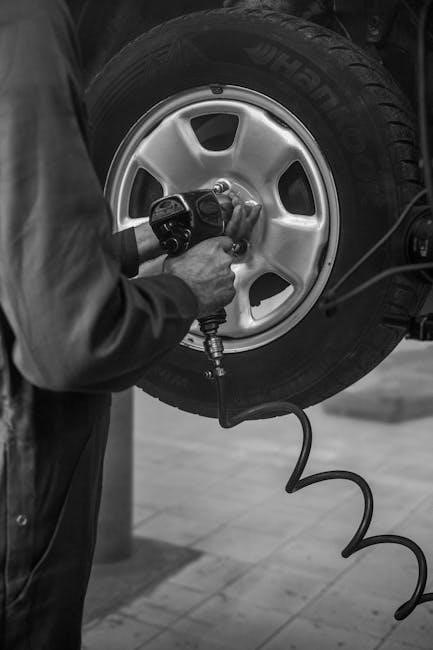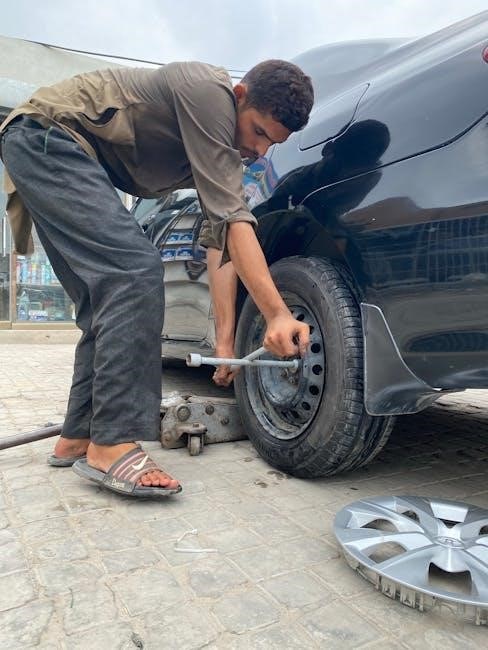Manual Tire Changing Tools: A Comprehensive Guide

This comprehensive guide explores the realm of manual tire changing tools, highlighting their importance for efficient tire maintenance. Whether you’re a seasoned mechanic or a novice driver, understanding these tools is crucial. We will cover essential tools, safety precautions, and a step-by-step process.
Manual tire changing might seem daunting, but with the right tools, it becomes manageable. This process offers independence and cost savings, allowing you to handle tire maintenance at home or on the road. This guide will delve into the world of manual tire changing, emphasizing the necessary tools and techniques.
Understanding manual tire changing empowers you to address flat tires and seasonal tire swaps efficiently. It saves money on professional services and ensures you’re prepared for unexpected situations. While some vehicles include basic tools, upgrading to more durable and efficient equipment enhances the process.
We’ll explore the essential manual tire changing tools, from jacks and lug wrenches to tire irons and bead breakers. Each tool plays a crucial role in safely and effectively removing and installing tires. By understanding the function of each tool, you can confidently perform tire changes and maintain your vehicle’s tires. This knowledge ensures you’re equipped for any tire-related challenge.

Essential Manual Tire Changing Tools
Changing a tire manually requires a specific set of tools to ensure safety and efficiency. A lug wrench is paramount for loosening and tightening lug nuts, securing the wheel to the vehicle. A reliable jack, either hydraulic or scissor, is essential for lifting the vehicle safely off the ground, providing clearance to remove the tire.
Tire irons or spoons are crucial for prying the tire bead from the wheel rim, allowing for removal and installation. Wheel wedges prevent the vehicle from rolling during the process, enhancing safety. A tire pressure gauge ensures proper inflation of the spare tire before installation.
Additional tools, such as gloves for hand protection, a flashlight for visibility in low-light conditions, and a mat to kneel on, contribute to a more comfortable and safe experience. Having these essential tools readily available streamlines the tire changing process, saving time and effort. Always ensure your tools are in good working condition before attempting a tire change.

Types of Manual Tire Changing Tools
Manual tire changing tools come in various forms, each designed for specific tasks and levels of user effort. Tire irons, also known as tire spoons, are fundamental for levering the tire bead over the rim. They vary in length and shape, offering different degrees of leverage and control. Bead breakers are specialized tools used to separate the tire bead from the wheel rim, often featuring manual or hydraulic operation.
Lug wrenches come in several types, including the standard L-shaped wrench, the X-shaped spider wrench, and torque wrenches for precise tightening. Jacks are available as scissor jacks, commonly found in vehicle trunks, and hydraulic jacks, offering greater lifting capacity and stability.
Valve core tools are used to remove and install valve cores for deflation and inflation. Tire pressure gauges are essential for ensuring proper tire inflation after the change. Wheel chocks or wedges prevent the vehicle from rolling during the process. Understanding the different types of manual tire changing tools allows for selecting the right equipment for specific needs and vehicle types.

Jacks: Hydraulic vs. Scissor Jacks
When it comes to lifting your vehicle for tire changes, jacks are indispensable tools. Two common types dominate the market: hydraulic jacks and scissor jacks. Scissor jacks, often included with vehicles, are mechanically simple and affordable. They operate by a scissor-like mechanism that extends as a threaded rod is turned, raising the vehicle. While compact, they typically have a lower lifting capacity and can be slower to operate compared to hydraulic jacks.
Hydraulic jacks, on the other hand, utilize hydraulic fluid to generate lifting force. They come in various forms, including bottle jacks and floor jacks. Bottle jacks are upright cylinders that provide high lifting capacity in a compact size, while floor jacks are larger and offer greater stability and ease of use.

Hydraulic jacks generally require less physical effort and can lift heavier vehicles, making them suitable for both home and professional use. When selecting a jack, consider your vehicle’s weight, the required lifting height, and the stability offered by the jack’s base. Always prioritize safety by using jack stands to support the vehicle once lifted.
Lug Wrenches: Types and Compatibility

A lug wrench is essential for loosening and tightening lug nuts, securing the wheel to your vehicle. Several types exist, each offering unique advantages. The most basic is the L-shaped lug wrench, often included with the vehicle. While simple, it may require significant effort, especially for tightly secured nuts.

Spider wrenches, also known as four-way lug wrenches, provide multiple socket sizes, increasing versatility. Their X-shape allows for greater leverage, making loosening stubborn nuts easier. Another option is the torque wrench, ensuring precise tightening to the manufacturer’s specifications, preventing over-tightening or under-tightening.
Compatibility is crucial. Ensure the lug wrench socket size matches your vehicle’s lug nuts. Using an incorrect size can damage the nuts or wrench. Some hubcaps may require specific lug wrench designs or adapters. Before purchasing a new lug wrench, check the spare tire storage for an existing one. If a standard wrench doesn’t fit, consider using zip-ties, nuts, bolts, or even duct tape as a temporary fix.
Additional Tools for Convenience and Safety
Beyond the essential jack and lug wrench, several additional tools enhance the tire changing process, boosting convenience and safety. A tire pressure gauge is crucial for ensuring the spare tire is properly inflated before installation. Tire spoons or tire irons aid in removing the old tire from the rim and mounting the new one, particularly useful for manual tire changers.
Wheel wedges prevent the vehicle from rolling while it’s jacked up, adding a layer of safety. A flashlight or headlamp provides illumination, especially during nighttime tire changes. Gloves protect your hands from dirt and grime, while a rain poncho keeps you dry in inclement weather.
Consider a 2×6 wood board to reinforce the jack, preventing it from sinking into soft surfaces. A jack stand provides additional support, enhancing stability. Reflective warning markers alert other drivers to your presence, increasing roadside safety. These extra items are not always a necessity but they will make the tire change a bit easier and comfortable for you.
Safety Precautions Before Starting
Prioritizing safety is paramount before commencing any tire changing procedure. Always park the vehicle on a level surface, engaging the parking brake firmly to prevent movement. Activate hazard lights to alert other drivers, especially in roadside situations. Deploy reflective warning markers approximately 30 feet behind the vehicle to provide additional visibility.
Before jacking up the car, ensure the wheel wedges are properly positioned, preventing rolling. Consult the vehicle’s owner’s manual to identify the correct jack points, avoiding damage to the frame or undercarriage. Never place any part of your body under the vehicle while it’s supported only by the jack.
Double-check the spare tire’s pressure before installation; a properly inflated tire is crucial for safe driving. Wear gloves to protect your hands from dirt and sharp edges. Keep all tools within easy reach to avoid unnecessary movement and potential hazards. Scan your surroundings for safety. Isnt it better to drive on a flat tire to a safe location than stop on a highway and cause an accident?

Step-by-Step Tire Changing Process Using Manual Tools
Begin by loosening the lug nuts on the flat tire using a lug wrench. Apply steady pressure, working in a star pattern to distribute force evenly. Once loosened, position the jack at the designated jack point and raise the vehicle until the flat tire is off the ground. Fully remove the lug nuts and carefully detach the flat tire.
Mount the spare tire onto the wheel studs, aligning the bolt holes. Hand-tighten the lug nuts in a star pattern to secure the wheel. Lower the vehicle using the jack until the spare tire makes contact with the ground, but the full weight isn’t yet applied.
Tighten the lug nuts further with the lug wrench, again following a star pattern. Once the vehicle is fully lowered, give the lug nuts a final tightening to ensure they are secure. After driving a short distance, re-check the lug nuts to confirm they remain tight. This process ensures a safe and secure tire change.
Post-Change Procedures: Tool Storage and Tire Inspection
After successfully changing the tire, proper post-change procedures are essential for safety and maintaining your equipment. Begin by carefully storing all the tools used during the process. Ensure the lug wrench, jack, and any other tools are placed back in their designated storage locations within your vehicle. This prevents them from becoming loose projectiles in case of sudden stops or accidents.
Next, thoroughly inspect the replaced tire. Check for any signs of damage, such as cuts, bulges, or embedded objects. If the tire appears repairable, take it to a professional tire shop for evaluation. Do not attempt to drive on a damaged tire for an extended period. If the spare tire is not a full-size tire, remember that it is intended for temporary use only.
Drive to a repair shop as soon as possible to have the flat tire repaired or replaced. Furthermore, it is advisable to check the tire pressure of all tires, including the spare, to ensure they are properly inflated according to the vehicle manufacturer’s recommendations. Proper storage and tire inspection contribute to your safety and the longevity of your tires.
Manual Tire Changers: Suitability for Different Vehicles

Manual tire changers offer a versatile solution for tire maintenance, but their suitability varies depending on the vehicle type. Generally, these changers are well-suited for standard passenger cars and light trucks due to their common tire sizes and weights. However, larger vehicles like SUVs or heavy-duty trucks may present challenges.
The primary limitations arise from the physical effort required to operate the manual changer and the size of the tires. Larger tires can be difficult to maneuver and mount using manual force alone. Some manual tire changers may lack the necessary clamping range to accommodate larger wheel diameters.
Before purchasing a manual tire changer, carefully consider the types of vehicles you intend to service. Check the specifications of the changer to ensure it can handle the wheel sizes and tire types of your vehicles. For larger vehicles, hydraulic or powered tire changers may be more appropriate, offering increased leverage and ease of use. Evaluate your needs to select the most suitable tool.
